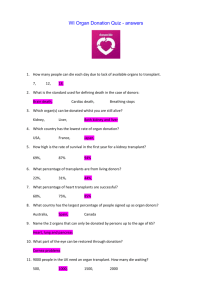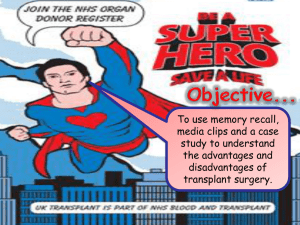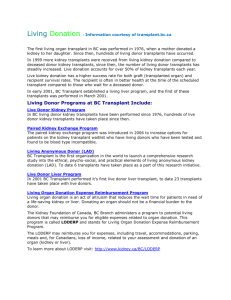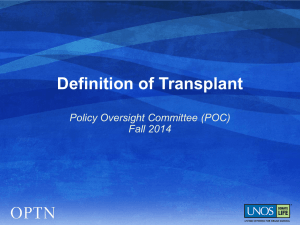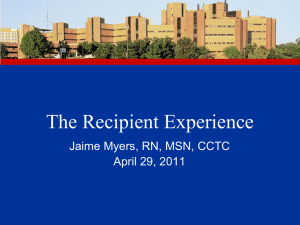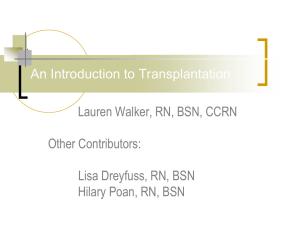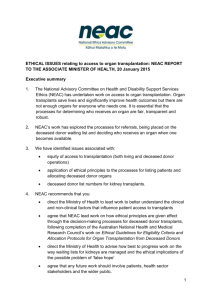Transplanting Human Organs
advertisement
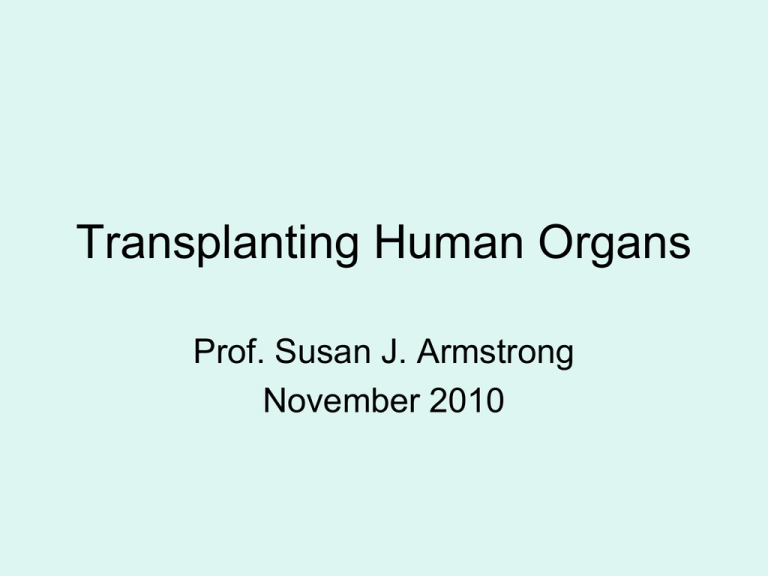
Transplanting Human Organs Prof. Susan J. Armstrong November 2010 The first Heart Transplant • Christiaan Barnard, a south African surgeon, was 44 years old when in 1967 he transplanted the heart of a 25 year old woman into the body of a dying 55 year old man. • The patient lived 18 days, dying from rejection of the organ. Reactions were mixed, the prevailing medical opinion being that the operation had been premature. Types of transplants • Living donor (lobe of the liver or a kidney) • Directed or non-directed. Sweden in 2004. • instituted non-directed, compensated donations • Cadaver (brain-dead) • 90% of organs come from these individuals (6000-7000/year). (Bresnahan 2010) Quality of life for donors and recipients • Cyclosporin, which blocks immune rejection of foreign tissue, was discovered in the early 1980s. • Today 75% of heart transplant patients survive for at least five years and 50-60% survive 10 years. • Over 60% of lung transplant patients survive over five years. Risk for donors • In Iran there is a regulated market for kidneys. A study in 2001 shows that vendors frequently feel worthless and shameful. Akin to prostitutes. Anxiety and depression. (Kerstein 2009) • However some argue that organ selling may improve the vendor’s situation. (Cherry 2000) • In US (Omar 2010) only 0.03% mortality Criteria of death • For thousands of years death included cessation of breathing and heartbeat. This is the whole-body standard of death. • This definition became inappropriate when ventilators were developed that allowed artificial respiration of brain-damaged patients. Criteria of brain death • Harvard criteria (1968): Very cautious: no behavior that indicated consciousness , flat EEG readings 24 hours apart. No brain activity. • Cognitive criterion: not legal in any state. Loss of “core properties” of a person. • Irreversibility standard. Unconsciousness is irreversible. Persistent vegetative state over one year • Uniform Brain Death Act. Loss of all brain function. – In several religions the ethics of brain dead organ donation continues to be controversial. – Conflicting Needs: • Doing everything possible for a comatose or dying patient • Allowing families closure and obtaining organs for transplantation • A few patients can make good recovery after being comatose for over a year. (7/434) Shortage of organs • There is a growing disparity between demand for and supply of organs. (Hippen 2009) • In 2009 worldwide 102,000 on transplant list. In 2008 fewer than 8000 donors and fewer than 22,000 transplanted organs. 15% of patients die on the liver transplant waiting list annually. Ethic of Care • Captures the moral situation of live kidney donations (Kane 2008) • Focuses on the concrete and contextual, concentrates on relationships. • “animism” : donor’s qualities are imagined to live within the recipient. Advantages of kidney transplant • Transplantation confers a good quality and longer life cf. to dialysis. Also cheaper. Currently 6% of Medicare spent on .6% of recipients. • Dialysis: blood run through a filtering membrane and returned to body. 3 x week for 4-5 hours each session. Need for organs for transplant • Which system would more successfully realize the goals of greater availability? • free market, state-regulated market, or blanket prohibition Possible exploitation • To exploit someone is to benefit by taking unfair advantage of that person. • International data: individuals who have sold their kidneys for cash are not financially improved 5 years later and describe their health and overall well-being as worse. Black market in organs • 41% of surveyed physicians believed they had treated a patient who had purchased an organ. Should there be a market for organs? • Monetary compensation is prohibited in US by National Organ Transplantation Act but some in the professional transplant community argue for a regulated commercial market for living kidney donations. (Aronsohn et al 2010) Transplant professionals in US • A majority opposed to a market for kidneys and partial livers. • Market value of living kidney graft: $766327,549 • Liver transplants more risky. • Market value of living partial liver graft: $18,663-69,080 • Risk: quality of life vs. surgical risk Main criticisms of regulated market • It would exploit vulnerable vendors and recipients: gray-market transactions in developing countries. • Two Kant-based moral constraints which some argue would make regulated organ market immoral: • 1. violates human dignity and incomparable worth Organ market • 2. treats others merely as a means. • In the world as we know it the organ market would be immoral. • For Kant everything that lacks incomparable worth has mere price, including human happiness and well-being • Living donors are otherwise healthy people who voluntarily submit to surgery. Currently their donation is a gift not a sale. Alternatives to a market in organs • Opt-out programs: citizens are presumed to consent to donating their organs at death but can opt out of donation if they choose. (Spain has this system and has the highest deceased donor rate in the world). (Kerstein 2009) Autonomy • Even those transplant physicians who support an organ market rated risk more important than patient autonomy and opportunity to earn money. • Also there is human flourishing, which would be diminished by a market. Possible non-monetary incentives • Guaranteed health insurance, life insurance, payment for lost wages, etc. Utilitarian considerations • In the U.S. prison inmates are entitled to organ transplants • An inmate on Oregon’s death row requested a kidney transplant, which would have saved Oregon money. But there are more than 59,000 Americans waiting for kidneys, nearly 200 in Oregon. Reasons for transplant for inmate • Morally wrong to reduce an inmate’s quality of life whether he is eventually executed or not. • 75% of death sentences are over-turned on appeal. • (Appel 2005) System of compensated donation is another possibility • A Register with compensation which will be the same at the savings made by the health care system from the elimination of 20 years of dialysis.$95,000 to 250,000. Transplant tourism • Poverty stricken persons in developing world are organ vendors at the mercy of brokers. Transplant tourism • Central Hippocratic commitment is to nonjudgmental regard. Doesn’t matter if they are enemy soldiers, prisoners, or have gone to China for transplant. • 2003 : an international study on kidney transplant traffic. recipients paid $100,000 while living donors had received $800. In China kidney 1000-10,000 and liver from executed prisoner 94000. • for donors after care generally not available. Liver transplants in China • 20-30% have hepatitis B virus. Liver disease a leading cause of death in PRC. • China like most Asian countries has no brain death law and so almost all come from living donors. • Yet 95% of liver transplants in PRC come from deceased donors (executed prisoners). • Survival close to that in US. 70% after 5 years. • (Rhodes 2010) Transplants in China or India • U.S. patients receive substandard care. Should they be treated in US? Yes ethics of medicine are strict : fiduciary responsibility: doctors are trusted agents of their patients’ welfare and beneficence. Presumed consent accepted in many countries. • Individual consent not thought to be ethically necessary and it is good to conserve scarce resources. • Consent: Sweden: legally presumed but close relatives can veto donation Presumed consent • To presume consent allows for the relatives of the deceased to simply confirm that donation can go ahead as opposed to undertaking the decision alone. (Cherkassky 2010) Presumed consent • • • • Problems: Undermines patient autonomy Assumes knowledge by patient Causes distress to relative • We could think of organ donation as a duty the dead owe to the living
